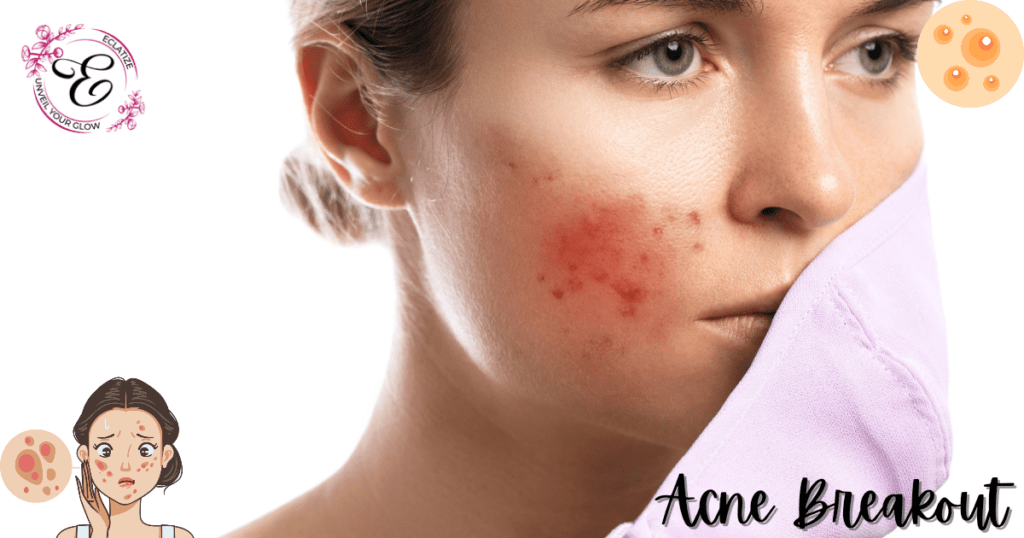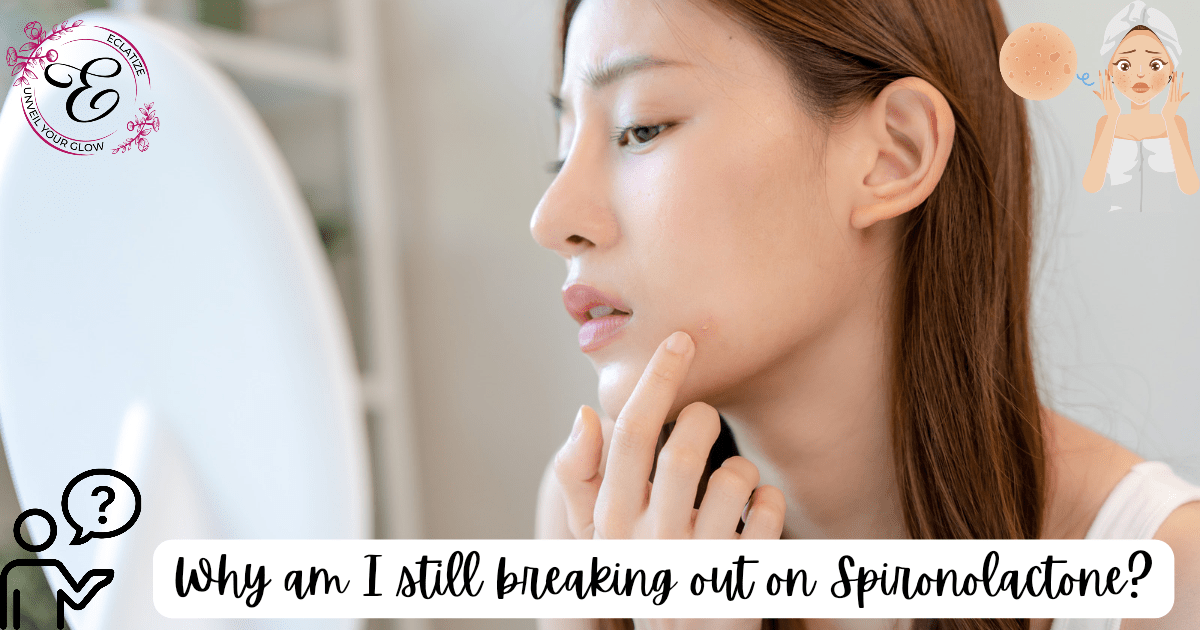“Why am I still breaking out on Spironolactone?” It’s a question many individuals undergoing acne treatment with Spironolactone often ask. This medication, renowned for its effectiveness in managing acne, can sometimes puzzle users when breakouts persist despite its use. Let’s dive deeper into this concern and explore why breakouts might continue even while using Spironolactone.
Table of Contents
What is Spironolactone?
Spironolactone, commonly known as a “water pill,” belongs to the diuretic family of medications. Initially prescribed for conditions such as high blood pressure and heart failure, it has gained traction for its ability to address hormonal acne, particularly in women.
Understanding Acne Breakouts

Acne, a prevalent skin issue, arises from multiple factors, including excess oil production, clogged pores, bacterial involvement, and inflammation. Hormonal fluctuations, especially in women, significantly contribute to persistent acne problems.
Spironolactone for Acne Treatment
How Spironolactone Works on Acne?
Spironolactone, primarily recognized as a diuretic medication, has an additional impact on hormonal regulation, particularly androgens like testosterone. When taken, it blocks the androgen receptors in the body, essentially inhibiting the effects of these hormones. By doing so, it reduces the production and influence of androgens that are responsible for stimulating oil glands, ultimately leading to excessive oil secretion on the skin.
This reduction in androgen activity helps to moderate oil production, which is a significant contributor to the development of acne. By controlling oil secretion, Spironolactone indirectly contributes to unclogging pores and minimizing the conditions favorable for acne-causing bacteria to thrive. Consequently, this medication assists in reducing the likelihood of new breakouts and contributes to clearer skin over time.
Its Effectiveness in Treating Acne
For many individuals, Spironolactone has showcased impressive results in controlling acne, leading to clearer skin and minimized breakouts. The response to this treatment differs for each person, showcasing the individual nature of its effects.
Factors Influencing Breakouts on Spironolactone
Several factors can contribute to breakouts while using Spironolactone:
Initial Side Effects: Some individuals might experience a temporary exacerbation of acne when they first start taking Spironolactone. This initial flare-up occurs as the body adapts to the medication.
Hormonal Adjustments: Hormonal fluctuations, particularly in women, can influence the effectiveness of Spironolactone. Variations in hormonal levels during different phases of the menstrual cycle or due to other factors might impact its ability to control breakouts consistently.
Understanding these factors can help individuals manage and navigate breakouts more effectively while using Spironolactone for acne treatment.
Tips to Manage Breakouts on Spironolactone
Skincare Routines
Adopting a consistent skincare regimen, including gentle cleansing, non-comedogenic products, and regular exfoliation, can significantly aid in controlling breakouts.
Diet and Lifestyle Changes
Incorporating specific dietary adjustments, stress management techniques, and ensuring adequate sleep can substantially contribute to overall skin health, complementing the effects of Spironolactone.
Consulting a Dermatologist
Importance of Professional Advice
Seeking guidance from a dermatologist is crucial for personalized acne management. They can assess individual skin conditions and suggest tailored treatments.
Discussing Concerns and Alternatives
Openly communicating any concerns or persistent breakouts with your dermatologist is vital. They might recommend dosage adjustments or alternative treatments to enhance Spironolactone’s efficacy.
Monitoring and Patience
Understanding the Treatment Timeline
Results from Spironolactone might take several weeks to become noticeable. Patience is key while waiting for the medication to demonstrate its full effects.
Being Patient with Results
Consistency in medication usage and adherence to suggested routines play a pivotal role in achieving clearer skin. Results may not be immediate but can be promising with time.
Addressing Common Myths About Spironolactone and Acne
There are several misconceptions surrounding Spironolactone’s use in acne treatment. Some common myths include:
Myth: Spironolactone is a cure-all for acne. While Spironolactone can be highly effective for many individuals in managing acne, it might not completely eradicate the condition for everyone. Results can vary, and it’s not a guaranteed cure for acne.
Myth: Spironolactone works instantly. Contrary to popular belief, the effects of Spironolactone on acne might take several weeks or even months to become noticeable. Maintaining patience while undergoing this medication regimen is crucial, given its diverse impact on individuals’ skin conditions.
Myth: Spironolactone is solely for women. Although Spironolactone is commonly prescribed for hormonal acne in women, it can be used by men as well. However, it’s essential to consult a healthcare professional before use.
Addressing these misconceptions helps individuals make informed decisions about Spironolactone as part of their acne treatment regimen.
Conclusion
While Spironolactone holds promise in managing acne, its effectiveness varies among individuals. Factors like hormonal changes, initial side effects, and skincare routines significantly influence its efficacy. Consulting a dermatologist, maintaining patience, and adopting a holistic approach to skincare are crucial for achieving clearer skin.
“Get complete guide on “Why am i still breaking out with a good skincare routine?” through our latest blogpost. Click on the link.
FAQs
Can Spironolactone completely cure acne?
While Spironolactone can be highly effective in managing acne, it might not be a complete cure for everyone. Effectiveness levels of this treatment vary individually, emphasizing the personalized outcomes each person might experience.
Are there any significant side effects of using Spironolactone for acne?
Common side effects of Spironolactone might include increased urination, dizziness, breast tenderness, and menstrual irregularities in women. Severe side effects are rare but can include allergic reactions or electrolyte imbalances. It’s crucial to discuss potential side effects with a healthcare provider.
How long does it usually take for Spironolactone to show results in acne treatment?
Results from Spironolactone can take time. While some individuals might notice improvements within a few weeks, it can take up to three months or longer to see significant changes in acne.
Can Spironolactone be used by men for acne treatment?
Yes, Spironolactone can be prescribed to men for acne treatment, especially when hormonal factors contribute to the condition. However, its usage in men may differ, and consultation with a healthcare provider is essential.
Are there any dietary restrictions while on Spironolactone for acne?
Specific dietary restrictions aren’t typically associated with Spironolactone for acne. However, reducing the intake of high-potassium foods or alcohol may be advised, as Spironolactone can affect potassium levels.

